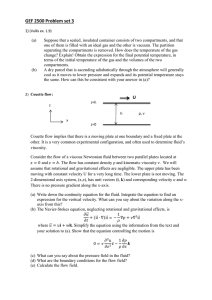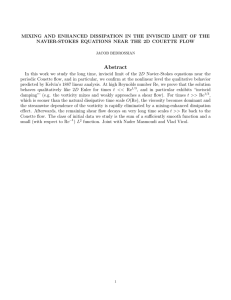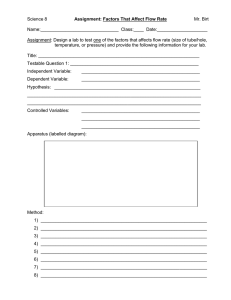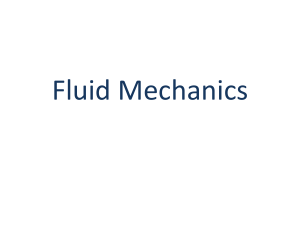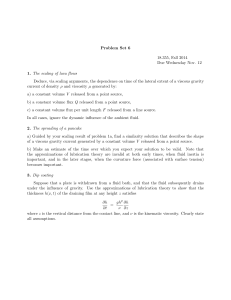The Effect of Heat Absorption on a Variable Viscosity Abstract
advertisement
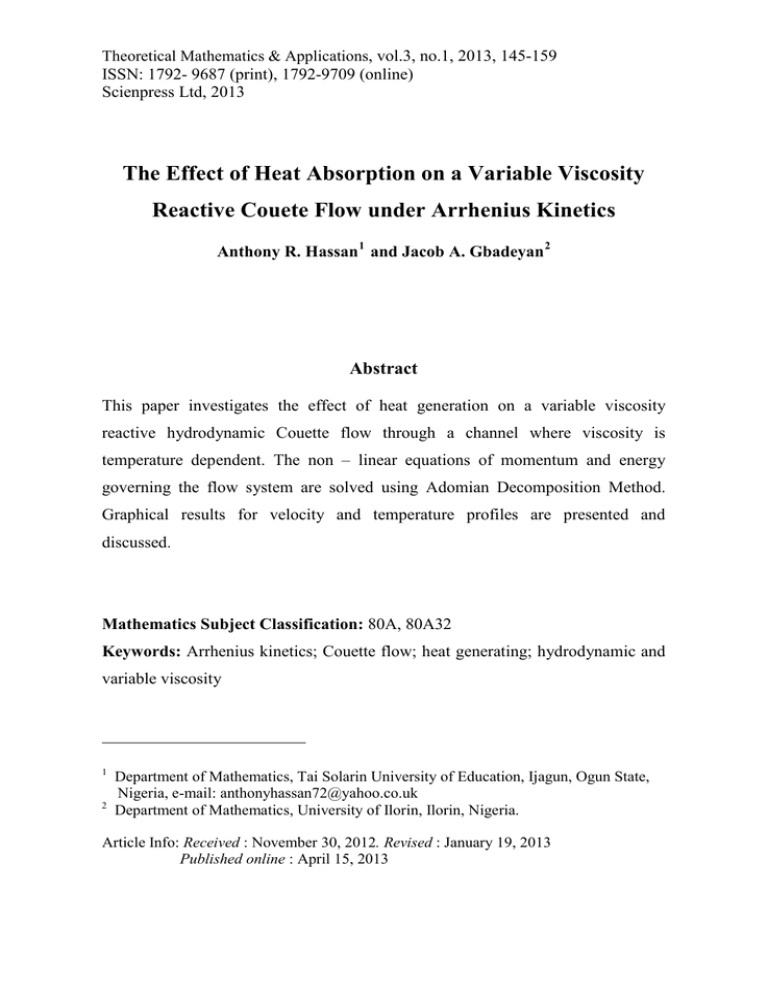
Theoretical Mathematics & Applications, vol.3, no.1, 2013, 145-159 ISSN: 1792- 9687 (print), 1792-9709 (online) Scienpress Ltd, 2013 The Effect of Heat Absorption on a Variable Viscosity Reactive Couete Flow under Arrhenius Kinetics Anthony R. Hassan 1 and Jacob A. Gbadeyan 2 Abstract This paper investigates the effect of heat generation on a variable viscosity reactive hydrodynamic Couette flow through a channel where viscosity is temperature dependent. The non – linear equations of momentum and energy governing the flow system are solved using Adomian Decomposition Method. Graphical results for velocity and temperature profiles are presented and discussed. Mathematics Subject Classification: 80A, 80A32 Keywords: Arrhenius kinetics; Couette flow; heat generating; hydrodynamic and variable viscosity 1 2 Department of Mathematics, Tai Solarin University of Education, Ijagun, Ogun State, Nigeria, e-mail: anthonyhassan72@yahoo.co.uk Department of Mathematics, University of Ilorin, Ilorin, Nigeria. Article Info: Received : November 30, 2012. Revised : January 19, 2013 Published online : April 15, 2013 146 1 The Effect of Heat Absorption on a Variable Viscosity Reactive Couete Flow Introduction The Couette flow of a reactive fluid has been of interest to many researchers of fluid mechanics due to its numerous engineering and industrial applications, for example, in lubrication coal slurries, polymer solutions or melts, hydrocarbon oils, grease etc. as discussed by N.S. Kobo and O.D. Makinde (2010). In this respect, various aspects of Couette flow have been studied, for example, J. Lopez – Lemus and R. M. Velasco (1999) studied the characteristics of the Couette flow in terms of temperature jump in the wall and the slip velocity. Also, G. Bodosa and A. K. Borkakati (2003) investigated an unsteady flow of an incompressible and electrically conducting fluid between two horizontal parallel plates, one of which is at rest, other moving in its own plane with a velocity in the presence of a uniform transverse magnetic field. Furthermore, Hazem Ali Attia (2005) examined the effect of hall term on the unsteady Couette flow of a visco elastic fluid under the influence of an applied uniform magnetic field whereas Isom Herron and Fritzner Soliman (2006) in their study showed that without the axial magnetic field, with only the torodial field due to an axial current, the Couette flow is strictly stable to linear axis symmetric disturbances. However, T. Hayat and A. H. Kara (2006) determined the exact solutions to the partial differential equation that arose in the modeling of a Couette flow of a third – grade fluid with variable magnetic field subject to certain initial and boundary conditions. Also, T. Hayat, M. Sajid and M. Ayub (2007) considered a series solution for generalised Couette flow using homotopy analysis method and its convergence. More so, S. Abelman, E. Momoniat and T. Hayat (2009) presented a numerical solution for the study of Couette of a thermodynamic compatible third grade fluid filling the porous space in a rotating frame where partial slip effects were taken into account. Considering the importance of reactive fluids because of the physical nature, especially in lubricants which are usually subjected to the differential heat exchange processes like in internal combustion engines. T. Chinyoka (2011) Anthony R. Hassan and Jacob A. Gbadeyan 147 modelled and numerically solved the shear flow of chemically reactive Oldroyd – B liquids subjected to thermal convections. Already, N.S. Kobo et al (2010) investigated the inherent irreversibility associated with the Couette flow of reacting variable viscosity combustible materials under Arrhenius kinetics and evaluated the entropy production. In addition, T. Chinyoka and O. D. Makinde (2011) developed an unconditionally stable and convergent semi – implicit finite difference scheme and utilise it to computationally investigate the transient heat transfer in the generalised Couette flow of a reactive variable viscosity third – grade liquid with asymmetric convective cooling and their result showed that there was a transient increase in both then fluid velocity and temperature with an increase in the reaction strength, viscous heating and fluid viscosity parameter. All the above investigations are restricted to heat transfer or heat and mass transfer problems. However, of late, the study of heat generation or absorption effects is important in view of several physical problems, such fluids as described in Ahmed M. Salem and Mohamed Abd El – Aziz (2008) undergone exothermic or endothermic chemical reactions in which they considered the problem of heat and mass transfer by steady flow of an electrically conducting fluid over a continuously stretching sheet in the presence of heat generation or absorption effects and mass diffusion of chemical species which is subjected to a strong external magnetic field. In a similar situation, Basant K. Jha and Abiodun O. Ajibade (2009) investigated the natural convective flow of heat generating/absorbing fluid between vertical porous plates with periodic heat input and concluded that the influence of suction/injection is suppressed by large value of heat sink. Most recently, S. Das, S. K. Guchhait and R. N. Jana (2012) investigated the radiation effects on unsteady MHD free convective Couette flow of heat generation/absorbing fluid and concluded that the interaction between the radiation, MHD effects, buoyancy forces and the heat generation induced by a vertical motion of the plate can affect the configuration of the flow field significantly. 148 The Effect of Heat Absorption on a Variable Viscosity Reactive Couete Flow In spite of all these studies, the heat generating fluid with radiation absorption has received little attention; hence the main purpose of this present investigation is to extend the work of N.S. Kobo et al (2010) and to study the effect of internal heat generating on a reactive hydrodynamic fluid through a channel where viscosity is temperature dependent. In the rest of the paper; in section 2, the problem is formulated, non – dimensionalised and is solved in section 3 using Adomian decomposition method. Presentations of analytical results of the problem are shown graphically in section 4 and section 5 gives the concluding remarks. 2 Formulation of the Problem Consider the steady flow of a reactive, viscous and incompressible fluid flowing in x – direction between two parallel plates of which the upper plate is moving with velocity u and the lower plate is kept stationary with width (H) and length (L). The heat absorption terms in this problem is assumed to be the type used in Basant K. Jha et al (2009) Q = Q0 (T0 − T ) (1) Also, the temperature – dependent viscosity µ and chemical reaction kinetic (G) can be expressed following N.S. Kobo et al (2010) as: E µ = µ0e RT E and G = QC0 Ae RT (2) With these conditions, the continuity, momentum and energy equations governing the fluid flow in dimensionless form is given thus: ∂u ∂v + =0 ∂x ∂y ∂u ∂u ∂p ∂ ∂u ∂ ∂u ∂v +v = − + 2ε 2 +ε 2 µ + µ ∂y ∂x ∂x ∂x ∂y ∂y ∂x ∂x ε 2 Re u (3) (4) Anthony R. Hassan and Jacob A. Gbadeyan 149 ∂v ∂ ∂u ∂v ∂v ∂p ∂ ∂v + v = − + 2ε 2 µ + ε 2 µ + ε 2 ∂x ∂y ∂x ∂y ∂y ∂y ∂y ∂x ε 4 Re u (5) T 2 ∂T ∂ 2T ∂T 2 ∂ T ε + λe 1+ βT + µφ − δT + = +v ∂y ∂y 2 ∂x 2 ∂x ε 2 Pe u where (6) 2 2 2 ∂u ∂v ∂u 2 ∂v +ε 2 + 2ε + ∂x ∂x ∂y ∂y . φ = Br 2ε 2 The following non dimensionalise quantities in (1) and (6) ( ) H E T − T0 x v y u ε 2L p y= , x= , u= , v= , ε= , T= , p= , L L U εU εL RT02 µU E Eµ 0U 2 − RT0 Br = e kRT02 Pe = ρC pUL k E , QEAa 2C0 − RT0 λ= e kRT02 , Re = ρUL , µ0 β= RT0 E , E , Q H2 µ − µ = e RT and δ = 0 k µ0 0 (7) Invoking the channel aspect ratio 0 < ε << 1 , and then axial pressure gradient ∂p = 0 is zero for Couette flow, then equations (3) to (6) become ∂x d du µ = 0 dy dy (8) 2 T du d 2T + λe 1+ βT + µ Br − δT = 0 2 dy dy where µ = e − T 1+ βT (9) (10) with the following boundary conditions u=0 T =0 on y = 0 and u =1 T = 0 on y =1 (11) For many cases of interest, we take β = 0 . A good example of this approximation is the Bratu – type equation for combustion as in Y.A.S. Aregbesola (2003). With (10) and β = 0 , (8) and (9) reduce to 150 The Effect of Heat Absorption on a Variable Viscosity Reactive Couete Flow d −T du e =0 dy dy (12) and 2 du d 2T + λ eT + e −T Br − δ T = 0 2 dy dy (13) Integrating (12), we obtain du = meT dy (14) where m is a constant of integration to be evaluated using the boundary conditions stated in (11). Substituting (14) into (13) to obtain d 2T + λeT + m 2 Br eT − δT = 0 2 dy (15) and more conveniently, (15) can be written as d 2T + γeT − δT = 0 2 dy (16) where γ = λ + m 2 Br and m is to be determined by using the boundary conditions. 3 Method of Solution For convenience, we take the approximation of the exponential function and show that the result converges for small parameters of δ and γ as: T2 e = 1+ T + + O(T 3 ) 2 T (17) Substituting (17) into (16), we obtain: d 2T T2 + γ (1 + T + ) − δT = 0 2 dy 2 (18) Anthony R. Hassan and Jacob A. Gbadeyan 151 Integrating (18), we obtain the integral equation, dT T2 = A + ∫ δT − γ (1 + T + ) dy dy 2 0 y (19) Where T ' (0) = A is a constant to be determined by using the boundary condition. Integrating (19) again, we have T2 T = Ay + ∫ ∫ δT − γ (1 + T + ) dy dy 2 0 0 y y (20a) In a better form, we obtain the following y y y y y y T = Ay + δ ∫ ∫ (T )dy dy − γ ∫ ∫ (1)dy dy −γ ∫ ∫ (T )dy dy − 0 0 0 0 γ 0 0 y y (T 2 ∫∫ 2 )dy dy (20b) 0 0 We define a series solution of the form ∞ T ( y ) = ∑ Tn ( y ) (21) n =0 Substituting (21) into (20b), we get ∞ y y ∞ y y y y ∞ T ( y) = Ay + δ ∫∫ (∑ T ( y ))dydy − γ ∫∫ (1)dydy −γ ∫∫ ∑ Tn ( y )dydy ∑ T ( y) = n n =n 0= 00 n 0 = 00 00n 0 2 γ ∞ − ∫∫ ∑ Tn ( y ) dydy 2 0 0 n =0 y y (22) We let the nonlinear term be represented as ∞ = B ∑ n ∑ Tn ( y ) n =0 n =0 ∞ 2 (23) Taking the Taylor’s expansion, we obtained few terms for Bn as follows B0 = (T0 ( y )) 2 B1 = 2T0 ( y )T1 ( y ) B2 = 2T2 ( y )T0 ( y ) + (T1 ( y )) 2 (24) B3 = 2T3 ( y )T0 ( y ) + 2(T1 ( y )T2 ( y )) ... Then the zeroth component of (22) can be written following the modification of A.M. Wazwaz and El-Sayed (2001) 152 The Effect of Heat Absorption on a Variable Viscosity Reactive Couete Flow y y T0 [ y ] = −γ ∫ ∫ (1)dy dy (25) 0 0 y y y y 0 0 0 0 T1[ y ] = Ay + δ ∫ ∫ (T0 )dy dy −γ ∫ ∫ (T0 )dy dy − y y y y 0 0 0 0 Tn+1[ y ] = δ ∫ ∫ (Tn )dy dy −γ ∫ ∫ (Tn )dy dy − γ γ y y 2 ∫0 ∫0 ( B0 )dy dy (26) y y 2 ∫0 ∫0 ( Bn )dy dy (27) Obtaining few terms of the series leads to T0 [ y ] = − γ 2 y2 T1[ y ] = Ay − (28) γδ y4 + γ2 y4 − γ3 y6 (29) 240 Aγ 3 Aδ 3 Aγ 2 5 γ 3 6 γ 2δ 6 γδ 2 6 γ4 8 T2 [ y ] = y + y + y − y + y − y + y − 6 6 40 720 360 720 2240 (30) γ 3δ 8 γ5 y + y10 − 2240 43200 A2γ 4 Aγ 2 5 Aγδ 5 Aδ 2 5 Aγ 3 7 Aγ 2δ 7 T3 [ y ] = y + y − y + y − y + y − 24 120 60 120 280 280 γ4 γδ 3 8 γ 3δ 8 γ 2δ 2 8 Aγ 4 9 γ5 (31) y8 − y − y + y + y − y10 + 40320 40320 13440 13440 4320 44800 γ 4δ 10 γ 3δ 2 10 γ7 127γ 6 127γ 5δ 12 y − y + y12 − y − y14 + 22400 44800 39916800 39916800 8985600 Taking the partial sum of the series, we have 24 24 3 T ( y ) = ∑ Tn ( y ) n =0 It is important to note that the accuracy of the series can be drastically improved by computing more terms of the series. γ 2 Aγ 3 Aδ 3 A2γ 4 γ 2 4 γδ 4 Aγ 2 5 y − y + y − y + y − y + y 2 6 6 24 24 24 30 Aγδ 5 Aδ 2 5 γ 2δ 6 γδ 2 6 γ 3 6 Aγ 3 7 Aγ 2δ 7 y + y + y − y − y − y + y − 60 120 360 720 180 280 280 γ 3δ 8 19γ 4 8 γδ 3 8 γ 2δ 2 8 Aγ 4 9 11γ 5 10 y + y − y + y + y − y − 1920 40320 40320 13440 4320 241920 γ 4δ 10 γ 3δ 2 10 127γ 5δ 12 127γ 6 γ7 y − + y − y + y12 − y14 22400 44800 39916800 39916800 8985600 T [ y ] =Ay − (32) Anthony R. Hassan and Jacob A. Gbadeyan 153 Using (32), we obtain u(y) by integrating (14) and we get: A A2 γ 2 Aδ Aγ 3 γ 2 A2γ A2δ γδ 4 y+( − )y + ( − + − )y + ( − )y 2 6 6 24 6 30 24 30 120 19 Aγ 2 A2γ 17 Aγδ Aδ 2 5 +( − − + )y 720 144 720 720 7 A2γ 2 19γ 3 2 A2γδ 17γ 2δ A2δ 2 γδ 2 6 (33) +( − − + + − )y 720 5040 315 5040 315 5040 A3γ 2 11Aγ 3 A3γδ Aγ 2δ Aγδ 2 7 +( − − + − )y 1152 2688 1152 280 640 A4γ 2δ 73 A2γ 3 83γ 4 55 A2γ 2δ 7γ 3δ A2γδ 2 8 +( − + + − − )y 10368 60480 181440 36288 17280 2160 11γ 2δ 2 A2δ 3 γδ 3 ) y 8 + O( y 9 )] +( + − 60480 6480 362880 u[ y ] = m[1 + where m is a constant to be determined using the boundary condition u(1) = 1. 4 Discussion of Results In this paper, we present the effects of internal heat generation on the variable viscosity reactive Couette fluid flow under Arrhenius kinetics through a channel with isothermal plates. Analytical result for the nonlinear ordinary differential equation for the temperature field is presented by Adomian Decomposition method. Effects of internal heat generation parameters (δ) are presented and discussed in this section. Table 1 shows the computation of rapid convergence of Adomian Decomposition Method. The use of Adomian decomposition method has been applied to a wide class of problems in the sciences; the method has shown reliable results in supplying analytical approximations that converge very rapidly. Figure 1 shows the blow up of solution γ. This shows that there exist upper and lower solutions with a critical turning point such that 0 ≤ γ < γ c and the effect of internal heat generation is significantly observed as γ tends to 2.8078627802 154 The Effect of Heat Absorption on a Variable Viscosity Reactive Couete Flow compared to 3.9528312148 in N.S. Kobo et al (2010). The reduction in the value is due to the presence of internal heat caused within the flow system. The fluid temperature profiles in the normal direction are shown in Figures 2 and 3. It is clearly noted that as heat generation parameter (δ) increases, the temperature reduces in the sense that there is absorption of heat in the process of flow as shown in Figure 2. Also, the contrast is observed in Figure 3 as the fluid temperature increases with increasing value of γ. This is attributed to an increase in heat generation within the flow system due to exothermic reaction of the reactants within the fluid. For both figures, the minimum and maximum temperatures are observed to be at lower and upper plate surfaces respectively. Table 1: Computation showing rapid convergence of Adomian Decomposition Method [y = 0.1, δ = 0.1and γ =0.1] n k Tn ∑T n =0 n 0 -0.0005 -0.0005 1 0.00500021 0.00450021 2 1.25005×10-10 0.00450021 3 -1.04175×10-9 0.00450021 Nu 3.0 c 2.8078627802 2.5 2.0 1.5 1.0 0.5 1 2 3 4 5 Figure 1: Graph showing the blow – up of γ Anthony R. Hassan and Jacob A. Gbadeyan 155 0.1, 0.1, 0.5, 1.5, 5 T =0.1 012 =0.5 010 =1.5 008 =5 006 004 002 0.2 0.4 0.6 0.8 y 1.0 Figure 2: Temperature Profiles for several values of δ 0.1, 0.2, 0.3, 0.4 0.5, T 0.05 =0.4 0.04 =0.3 0.03 =0.2 0.02 =0.1 0.01 0.2 0.4 0.6 0.8 1.0 y Figure 3: Temperature Profiles for several values of γ 0.1, 0.5, 1, 2 0.5, u 1.0 0.8 0.6 0.4 0.2 0.2 0.4 0.6 0.8 1.0 Figure 4: Velocity profiles for several values of γ y 156 The Effect of Heat Absorption on a Variable Viscosity Reactive Couete Flow Figures 4 and 5 show the velocity profiles for increasing values of δ and γ. It is observed that the fluid velocity is zero at the lower stationary plate and increases gradually towards the upper plate that is moving. As δ and γ increases, the Arrhenius kinetic increases making the profile to increase nonlinearly across the channel to the upper moving plate where y = 1. 0.1, 0.5, 1.2, 2.5 2.5, u 1.0 0.8 0.6 0.4 0.2 0.2 0.4 0.6 0.8 1.0 y Figure 5: Velocity profiles for several values of δ 5 Conclusion We have investigated the effect of heat absorption on a variable viscosity reactive hydrodynamic Couette flow through a channel where viscosity is temperature dependent. The non – linear equations of momentum and energy governing the flow system are solved using Adomian decomposition method. Comparing the result to N.S. Kobo et al (2010), there is great influence of heat generation parameter on the flow system and that it is significant in the reduction of the fluid temperature. Acknowledgement The authors will like to appreciate Dr. Samuel Olumide Adesanya (of Redeemer’s University, Redemption City, Nigeria) for his valuable contributions. Anthony R. Hassan and Jacob A. Gbadeyan 157 List of Constants Nomenclature L Channel characteristic length μ E Activation energy Re Reynolds number G Reaction Kinetic U Viscosity Velocity scale (ms-1) R Universal gas constant Pe Peclet Number ρ Fluid density k ε Channel aspect ratio (Wm-1k-1) λ Frank – Kamenettski parameter Q Heat generation term (W) β Activation energy parameter Br Brinkman number δ Heat generation parameter Qo Dimensional heat generation T Fluid temperature (k) To plate surface temperature (k) A Reaction rate constant Co Reactant species initial p Pressure concentration u Axial velocity (ms-1) Thermal conductivity coefficient coefficient 158 The Effect of Heat Absorption on a Variable Viscosity Reactive Couete Flow References [1] Ahmed M. Salem and Mohamed Abd El – Aziz, Effect of Hall currents and chemical reaction on hydromagnetic flow of a Stretching vertical surface with Internal heat generation/absorption, J. of Applied Mathematical Modelling, 32, (2008), 1236 – 1254. [2] A.M.Wazwaz and El-Sayed, A new modification of the Adomian decomposition Method for linear and nonlinear operators, J. of Applied Maths Computation, 122, (2001), 393 – 405. [3] Basant K. Jha and Abiodun O. Ajibade, Free convective flow of heat generating/absorbing fluid between vertical porous plates with periodic heat input, J. of International Communications in Heat and Mass Transfer, 36, (2009), 624 – 631 [4] G. Bodosa and A. K. Borkakati: MHD Couette flow with heat transfer between two horizontal plates in the presence of a uniform transverse magnetic field, Theoret. Appl. Mech., 30 (1), (2003), 1 – 9. [5] Hazem Ali Attia: Unsteady Couette flow with heat transfer of a viscoelastic fluid considering the hall effect, Kragujevac J. Sci., 27, (2005), 5 – 22. [6] Isom Herron and Fritzner Soliman: The stability of Couette flow in a torodal magnetic field, J. of Applied Mathematics Letters, 19, (2006), 1113 – 1117. [7] J. Lopez – Lemus and R. M. Velasco: Slip boundary conditions in Couette flow, J. of Physica A, 274, (1999), 454 – 465. [8] N. S. Kobo and O. D. Makinde: Second Law Analysis for a Variable Viscosity Reactive Couette Flow under Arrhenius Kinetics, Hindawi Publishing Corporation Mathematical Problems in Engineering, 2010, (2010), 1 – 15. [9] S. Abelman, E. Momoniat and T. Hayat: Couette flow of a third grade fluid with rotating frame and slip condition, J of Nonlinear Analysis: Real world Applications, 10, (2009), 3329 – 3334. [10] S. Das, S. K. Guchhait and R. N. Jana: Radiation effects on unsteady MHD Anthony R. Hassan and Jacob A. Gbadeyan 159 free convective Couette flow of heat generation/absorbing fluid; Int. J. of Computer Applications, 39(3), 2012, 0975 – 0987. [11] T. Chinyoka: Two – dimensional flow of chemically reactive viscoelastic fluids with or without the influence of thermal convection. J. of Commun Nonlinear Sci Numer Simulat 16, (2011), 1387 – 1395. [12] T. Chinyoka and O. D. Makinde: Analysis of transient generalized Couette flow of a reactive variable viscosity third – grade liquid with asymmetric convective cooling, J. of Mathematical and Computer Modeling, 54, (2011), 160 – 174. [13] T. Hayat and A. H. Kara: Couette flow of a third – grade fluid with variable magnetic field, J. of Mathematical and Computer Modeling, 43, (2006), 132 – 137. [14] T. Hayat, M. Sajid and M. Ayub; A note on series solution for generalized Couette flow, J. of Communications in Nonlinear Science and Numerical Simulation, 12, (2007),1481 – 1487. [15] Y.A.S. Aregbesola: Numerical solution of Bratu problems using the method of weighted residuals, Electric Journal of Southern African Math. Sci Association (SAMSA), 3, (2003), 1 – 7.

